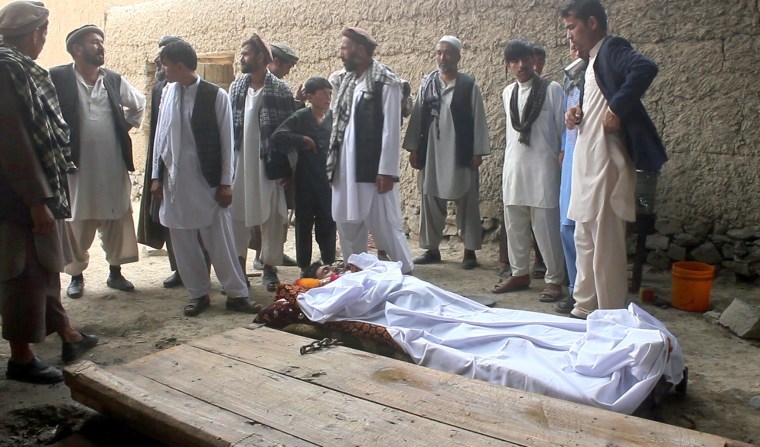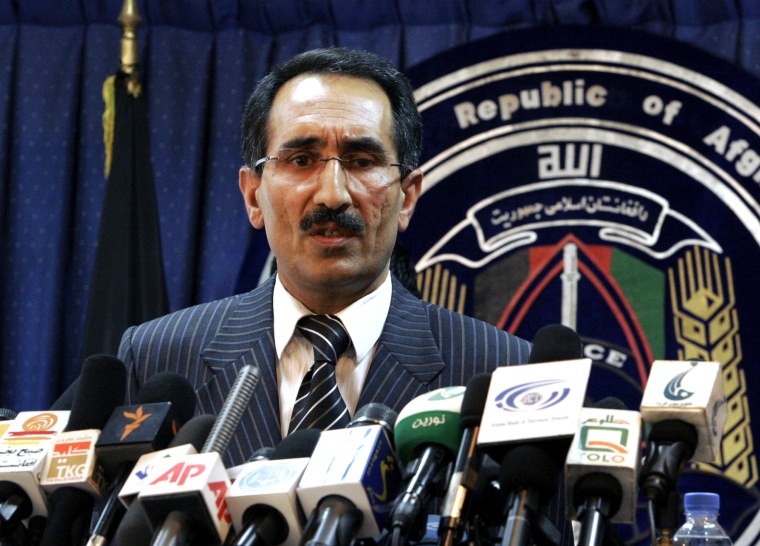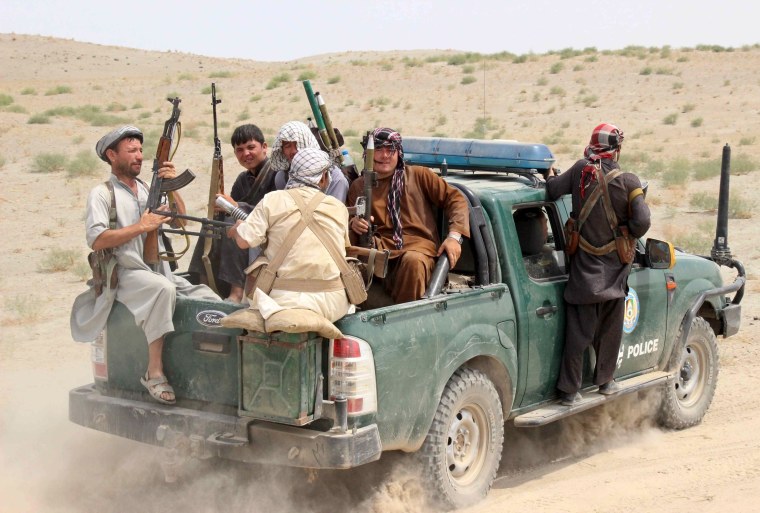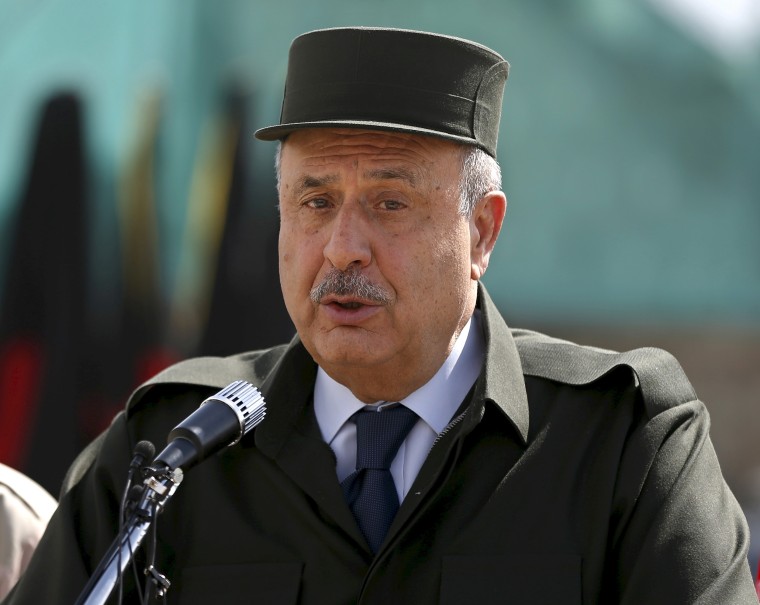KABUL, Afghanistan — What started as a wedding with hundreds of guests eating and dancing ended in tragedy when armed men took out their AK-47s and fired into the crowd of revelers.
The bride and groom survived, but 22 others died in the Afghan village of Shashan on July 26 — 16 of them relatives of Mohammad Ghani, a police officer who witnessed the massacre firsthand. Powerless to prevent the attack, Ghani says he doesn’t know what prompted onslaught.

“There was no reason for these guys to shoot except that they had guns and could,” the 44-year-old said. “None of the culprits have been caught even though they are part of a well-known band of outlaws.”
The massacre is part of a much larger problem that he says is growing throughout the country.
“The culture of guns disappeared for a few years, but it is coming back and it is causing insecurity in areas that were safe and secure a year or two ago,” he said.
Afghanistan is becoming more violent. Armed groups — some supported by the U.S.-backed government in Kabul and who act as local police forces known as "Arbaki," others fighting to overthrow that government, and some that are just gangs of bandits — are wreaking havoc in parts of Afghanistan.
So despite some $110 billion the U.S. has spent on relief, reconstruction and military aid to Afghanistan, the country is arguably more dangerous than it has been since the Taliban fell to American-backed forces nearly 15 years ago.
“If Afghanistan fails and drowns into chaos, it will have severe effects on the world and on the U.S. in particular"
Afghan civilian casualties are hitting their highest levels on record, with 1,592 killed and 3,329 injured during the first six months of the year, according to the United Nations. When the U.N. began to systematically compile casualty statistics in 2009, they recorded 1,052 deaths and 1,439 injured over the same period.
As foreign troops continue to draw down sharply with plans to leave completely in 2016, the government says that an average of between 10 and 15 Afghan national army and police members are being killed every day.
Friday's massive deadly truck bombing in the heart of Kabul underlined how militants were striking deeper into areas that had been relatively safe. The Taliban's leadership struggle, and the growing presence of fighters pledging their loyalty to ISIS, also raise the specter of even more violence.
But while the Taliban and other anti-government forces are still responsible for most civilian casualties, a growing number of Afghans are being killed and injured by those supposedly meant to protect them. According to the U.N., the number of deaths and injuries at the hands of pro-government forces jumped by 60 percent in the first six months of the year.
Related: Highest Number of Women, Kids Killed and Wounded on Record
As the violence worsens, there are growing worries that that Afghanistan is looking a lot like it did in the early 1990s after Soviet troops pulled out and the Moscow-backed government resorted to local militias to fight off an Islamist insurgency. The regime eventually collapsed, and the country plunged into a civil war from which emerged the Taliban.
“If Afghanistan fails and drowns into chaos, it will have severe effects on the world and on the U.S. in particular,” said Lt. Gen. Abdul Hadi Khalid, Afghanistan’s former deputy interior minister and a prominent critic of government policies. “They made the mistake in the 1990s and saw what happened, and it seems they are making the same mistake again.”

Khalid placed much of the blame for the growing violence on the Western military drawdown and reduced support generally. NATO has around 13,000 troops in the country, including around 10,000 American ones. That's down from 150,000 foreign troops there in 2011.
“The main problem here was that international forces left the country and the war was left to Afghan forces who were not fully equipped and not really quite ready to take on the job,” he said. “No army can fight this kind of war, while not having air power and proper equipment.”
Security has gotten dramatically worse throughout Afghanistan but markedly in the north of the country, which the Taliban never fully conquered and struggled to gain a foothold in until recently, according to Zakia Sangeen, a member of parliament for Parwan province.
The Taliban has established bases in some of the valleys in the north, while in other areas illegal armed groups roam freely, she said.
“It looks like a battlefield when you visit some of the villages,” Sangeen said. “Everyone carries around their weapons, even farmers on their fields carry AK-47s.”
“I used to go around villages freely, but now I can’t — I have to take a large number of armed security guards when I go and visit people. It is depressing to see how quickly things have changed,” she said.
"Wherever they see an opportunity, the act outside the law and there is not a good mechanism to keep them under control"
Sangeen’s constituents in Parwan — which is next to Kabul and is home to the massive Bagram Air Base — would not carry weapons if they felt safe, she said.
And time is running out to reverse trend, she warned. “This is not some remote province like Helmand — it sits on the throat of Kabul and a collapse of Parwan means the collapse of Kabul and the government of Afghanistan.”
While there are just under 200,000 Afghan National Army soldiers and around 160,000 Afghan National Police, security forces are badly overstretched in their war on a resurgent Taliban and struggling to hold territory as foreign troops leave.
Part of a solution to these sorts of local threats that Kabul and its American backers are proposing are local police forces, or Afghan Local Police (ALP) — commonly referred to as "Arbaki." The idea is that the groups are chosen by local villagers and vetted, trained and equipped by the government in Kabul. The program, paid for by the U.S., began with 10,000 conscripts in 2010 and has now grown to about 30,000 ALPs in 16 provinces.
It has not worked as well as some envisioned.
“The Arbaki forces could be useful in some areas as they are from those places, and know them very well,” a commander with a police unit in northern Kunduz province told NBC News on condition of anonymity because he is not authorized to speak to the press.
The problem is that they are not regular forces and while they are supposed to answer to the national police, they usually operate independently. This makes them a “very unreliable partner,” he said.

And although some are seasoned and brave fighters, they often abandon their posts, the commander added. Making matters much worse, many of the groups have resorted to settling old scores and fallen into criminality, the source said.
“They extort people’s belongings and even destroy people’s homes on charges of sympathizing with the Taliban, but in reality it is just local rivalries,” he said. “In some areas [national police forces] lose the support of locals because they see us siding with these militias.
“Wherever they see an opportunity, the act outside the law and there is not a good mechanism to keep them under control,” he added.
The International Crisis Group, which carries out research on conflict and promotes polices to prevent or resolve conflict, also raised the alarm on the local Arbaki militias earlier this year.
“The ALP and pro-government militias are cheap but dangerous, and Kabul should resist calls for their expansion,” it said in a report published June 4.
Not only do the groups tend to circumvent the central government, they also resemble “militias that had contributed to the civil wars of the 1990s,” the report added.
Officials agree that there have been some issues with the local police forces but insist that they are minority problem.
“In many provinces if the local police has the support of the people, the result is very good,” Afghanistan’s Interior Minister Nur ul-Haq Ulumi told NBC News. “In some places or some provinces when the local police [doesn’t have the] support of all the people ... the result is not so good.”

His ministry said it has received complaints about ALP members, but did not have an exact number of current or former Arbaki who had been prosecuted for mistreating civilians.
When asked about the reports of abuses at the hands of local police forces, U.S. military officials in Kabul said the ALPs were effective when they were integrated with other national security forces.
“ALP are often called the first line of defense for Afghanistan, maintaining security in the most austere locations,” said U.S. Army Col. Brian Tribus, director of public affairs for NATO’s Resolute Support mission. “The ALP is an Afghan solution, it falls in line with traditional Afghan culture with modern accountability."
While there had been “concerns” about the forces in the past, “the [Interior Ministry's] senior leadership is working to correct these problems,” he told NBC News in a statement.
Tribus also said that while the current agreement between the two governments “does not have any conditions specifically tying oversight and accountability with the ALP, there is a condition which prevents the use of funds for units that have committed a gross violation of human rights.”
The U.S.-backed policy of laying much of the responsibility on the groups makes very good sense from a counterinsurgency perspective, according to Peter Roberts, a senior fellow at London-based defense think tank RUSI and a former Royal Navy officer.
“Part of the surge doctrine is to exploit local militias, where you can, but understanding that you will not be able to control them,” he said.
Related: Are Afghans Ready for the Taliban's Return?
As foreign powers withdraw, as the U.S. and other Western armies are doing from Afghanistan, militias like the Arbaki can be very effective in defeating militants like the Taliban, even if they sometimes fuel violence and insecurity, Roberts said.

The Arbaki cannot be expected to behave like regular military or police forces, however, he said.
“These guys [aren’t] going to be able to fight with Western liberal ethics, doctrines and beliefs,” Roberts said. “And that has got to be something that you accept — it has got to be a political decision to accept it — because militarily it is the most effective way of ending an insurgency.”
That will take time, Roberts added.
“I would be very surprised if we see some kind of permanent stability within one or two years but I do think we will be well on the path to it within five years,” he said.
Khalid, the former deputy interior minister, counters that Afghanistan's time is running out.
“There is still a chance to change course and rescue Afghanistan,” he said. “If the political leadership of the country really acts quickly ... and the international community changes its attitude towards Afghanistan and acts responsibly, things can change for the better.”

